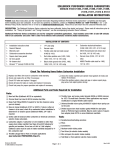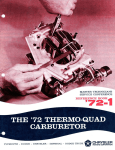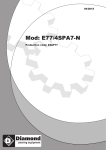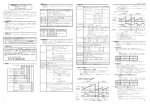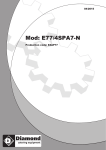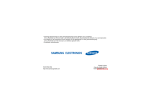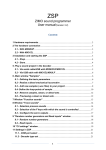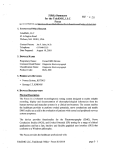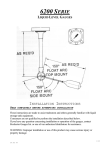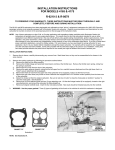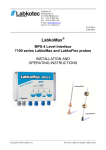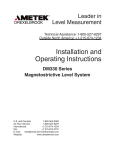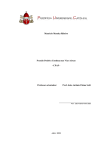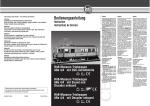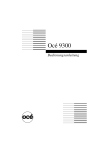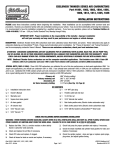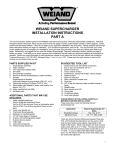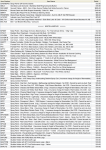Download Carter Thermoquad Information Guide
Transcript
Carter ThermoQuad Information Page
Overview
The Carter ThermoQuad carburetor is an American designed and built carburetor, and
was original equipment on many American Chrysler V8 vehicles built during the 1970s.
It was fitted to Australian manufactured Ford vehicles fitted with V8 gasoline engines
built between 1977 and 1982. These years correspond to the Falcon models XC through
to XE.
The Carter Thermo-Quad is a four-barrel carburetor with a spread bore throttle bore
configuration. It was designed as an emissions capable carburetor that retained or
surpassed secondary throttle performance of earlier Carter carburetors, while delivering
superior primary fuel economy. The Thermo-Quad consists of three main sub-assemblies;
an aluminum fuel bowl cover, a phenolic resin main body, and aluminum throttle base
assembly. The Thermo-Quad derives its name from the phenolic main body. Due to the
material of the body, the carburetor bowl can stay 20 degrees cooler than an all-metal
carburetor in the same environment. Chrysler Corporation used the Thermo-Quad in cars
and trucks 1971-1984. Carter also produced aftermarket versions.
This guide is intended to provide information for identifying Thermo-Quad carburetors
and related items. It provides a basic history and basic descriptions of the carburetor and
its subsystems. It is not intended as a full theory of operation manual or a repair manual.
Service documentation should be consulted for repair procedures and service details. The
factory service manuals provide good service procedures and theory for specific models.
Other sources may be consulted for general repair and modification procedures as well as
theory of operation. See the list of references for sources.
This guide is written with carburetor 'swapping' in mind. Thus, certain items are
discussed with modification consideration (ie. emission subsystem disablement) with the
intent for adapting a non-original carburetor and/or enhancing performance. The
modification and adaptation of the carburetors may present legal issues, so consider the
interest of any appropriate government(s).
As fitted to Australian vehicles, the ThermoQuad is a two-stage four-barrel carburetor
with electrically activated automatic choke. It is a spread bore design, with secondary
throats twice the size of the primaries. See the picture below for an illustration of the
relative size of the throttle bores. The secondary throttles are opened by a mechanical
linkage to the primary throttles, starting to open when the primary throttles are roughly
3/4 open, with both primary and secondary throttles becoming fully open at the same
time. A spring loaded, vacuum operated air-door above the secondary throats prevents
airflow through the secondaries until engine demands are sufficient to use the extra flow,
thus aiding a smooth transition to wide-open throttle.
Features
The Carter ThermoQuad features a plastic (phenolic resin, actually) main body (visible as
the dark center section in the above photographs). The main body contains the fuel
reservoir, and the plastic construction is claimed to keep the fuel cooler than a metal body
would, thus enabling more accurate fuel metering.
The primary fuel metering system features mechanical and vacuum controlled metering
rods, which eliminate the need for a power valve circuit within the carburetor. Opening
the throttle mechanically raises the metering rods proportionally, thus richening the
mixture according to throttle position. Rod position, and hence mixture richness, is
further controlled by engine vacuum, resulting in a fuel mixture that is always tailored to
instantaneous engine load.
The carburetor is fully tunable. External idle mixture screws enable precise adjustment of
the idle mixture. The primary circuit metering rods are adjustable and replaceable without
disassembly of the carb. The primary metering circuit also includes replaceable jets, and
replaceable metering rod step-up springs. Variation of step-up spring strength and preload
enables adjustment of the rate at which the mixture richens in relation to engine vacuum
and hence load. The secondary metering circuit features replaceable jets. It is also
possible to adjust the rate at which the secondary air-door opens, enabling activation of
the secondary throats at higher or lower engine loads, depending on the needs of a
particular engine.
The automatic choke mechanism features automatic choke activation, automatic choke
pull-off, an initial throttle setting for starting, an automatically reducing throttle setting as
the engine warms up, and disabling of the carburetor secondary throats whilst the engine
is cold. The choke activation temperature, pull-off rate, and cold-engine fast idle speed
are all fully adjustable.
Two timed-vacuum ports are provided on the front of the carburetor base.
PERFORMANCE CONSIDERATIONS:
Although not having a reputation locally as a performance carburetor, the Carter
ThermoQuad is nonetheless a sizeable four-barrel carburetor. The fully adjustable nature
and spreadbore configuration enables tuning for maximum power at wide-open throttle,
with excellent economy and emissions under cruise and idle conditions. American
ThermoQuads are rated at between 800cfm and 1000cfm, which is more than enough for
almost any street driven engine, and these carburetors have been popular aftermarket
fitments in that country. Hearsay has it that Australian ThermoQuads are rated at 600cfm,
although I have not been able to confirm this. Even at 600cfm, this represents air-flow the
equivalent of the most popular performance Holley four-barrel.
History and Description...
General:
The Thermo-Quad (TQ) was initially released for competition in 1969. Chrysler
introduced the TQ on the 1971 340. The first series of TQs including the 71 340 version
and the Competition Series TQs were air metered units unlike like the 72 and later TQs
which were solid (liquid) fuel metered. The Competition Series (CS) was available in 850
cfm and 1000 cfm ratings. CS units use a manual choke and have a minimal amount of
external attachments compared to OEM production units. The CS was discontinued in the
mid-70s. Carter released the 9000 series in the latter 70s as replacement carburetors for
Chrysler and GM Quadrajet applications. The 9000 series was very similar to the
production Chrysler Thermo-Quads.
In 1972, the OEM Chrysler TQs changed to the solid fuel metering type. The TQ
coverage was expanded to include the 400 engine. By 1973, all Chrysler 4-bbl
applications were TQs (except some 413 truck models which continued to use a Holley
carburetor). As the years progressed, the TQ evolved to meet the continually tightening
emissions requirements. The changes were numerous. Many features were added or
modified externally and internally. The late 70s contained many variations for the various
geographic regions, the various features included/excluded, and the range of applications
and engines produced. Into the 80s, the TQ became more complex, but year-to-year
major variation lessened somewhat. In 1973, TQs received a port on the base for canister
purge and a port on the main body to provide a venturi vacuum signal for EGR
applications. 1975 saw the introduction of the Idle Enrichment system, Altitude
Compensator on some models, and the Throttle Position Solenoid for the new catalytic
converter equipped cars.
In 1976, Chrysler introduced Lean Burn ignition and the TQ was modified to produce
and run on a very lean air/fuel mixture. An external idle stop switch and throttle position
transducer were added. In 1978, the TQ bowl vent was modified with the addition of an
electric Bowl Vent solenoid. An additional rear base port for the vent hose replaced the
bowl vent port. The fuel inlet moved to the rear center of the carburetor from the previous
rear side location. Lean Burn became Electronic Spark Advance (ESA) in 1979. The very
lean mixture idea was abandoned, but the electronic control of the ignition advance was
retained. Hidden mixture screws were a feature starting with some 1980 model TQs.
1981 introduced a riveted cover for the choke pull-off linkage to prevent tampering and
the oxygen feedback solenoid on some models. Idle Enrichment and Altitude
Compensator was not used on feedback models. 82-84 did not change much more in a
major way. The canister purge was eliminated by 1984 in some applications and a power
brake port was added to the rear base.
After 1984, Chrysler stopped using Thermo-Quads. Instead, the Rochester Quadrajet was
used through 1989 on cars and until 1988 in trucks when Electronic Fuel Injection
replaced them. Carter continued to supply the fuel pumps for the Quadrajet equipped
vehicles. Although Chrysler was the primary manufacturer to use the TQ, International
Harvester (IHC) used them in the late 70s and Ford used them in 1974.
The Thermo-Quad was available with two primary throttle bore sizes, 1-3/8" and 1-1/2".
Flow ratings (CFM) vary depending on the source, but the TQs with the 1-3/8" bores are
listed as 750-800 CFM and those with the 1-1/2" primary throttle bores are rated at 800850 CFM. All TQs have the 2-1/4" diameter secondary throttle plates. The primary bore
size depended on application. In general, all 78 and later 318s and 360s and all 340s had
the smaller bore. Earlier 360s varied depending on application, most 400s and all 440s
had the large bore. The 9000 series have the small primary bore and were rated by Carter
at 800 cfm. Later TQs (ie, Lean Burn and ESA applications, feedback systems) are
quoted with less flow ratings, but this is due to the control of the carburetion system, not
the inherent flow capability of the basic carburetor. The internal metering is set for leaner
running conditions for Lean Burn. Either bore size can be tuned to run well on most
engine combinations. The smaller bore offers a slight increase throttle response but less
overall flow. The different bore sizing, ie. spreadbore, is an aspect that can lead to
increased fuel economy while delivering similar wide open throttle (WOT) performance
to an equivalent standard bore configuration. The adjustability of the TQ and the
spreadbore configuration allows the use of a large CFM carburetor on a small
displacement engine.
The TQ gets its name from the phenolic resin main body. This is "sandwiched" between
the aluminum bowl cover assembly and the lower throttle flange assembly. The plastic
body keeps the fuel ~20 degrees cooler than an all metal carb in the same environment,
leading to less percolation problems and increased performance due to a denser charge.
The TQ is a metering rod based carburetor like other Carters (AFB, AVS, BBD). The
primary jets are housed in the plastic body; the primary metering rods are suspended from
the cover mounted step-up piston assembly into the jets (in the 71 TQ and the CS, the
primary jets are also housed in the cover). Engine vacuum (related to load) controls the
position of the metering rod in the jet, metering the fuel flow. The secondary jets are
suspended from the cover. Secondary flow is controlled by variable venturi effect in the
secondary bores. The TQ secondary throttle plates are controlled by direct mechanical
linkage, airflow is controlled by a secondary, spring tension resisted, air valve. The valve
is further controlled and damped by the choke pull-off diaphragm.
The OEM TQs have a divorced choke (73-up with electric assist in most applications),
the 9000 series have an integral electric choke, and the CS was equipped with a manual
choke. All OEM TQs and later CS have screw-in jets. Early CS retained the jets via Orings.
Identification:
To identify TQs, the model number is stamped on the lower left rear bolt flange. Earlier
TQs also had a tag under one of the front bowl cover screws, later ones have a bar code
sticker on the bowl cover with the Carter model and/or a Chrysler part number.
International Harvester TQs also have a tag under a front bowl cover screw.
Additional numbers will be found on the carburetor sections. These numbers are not used
for TQ identification, but some can be used to relate one casting to the other (note that
parts with the same casting number may be machined differently). The upper bowl cover
has the casting number on the top, right of center rear: 6-XXXX (example: 6-2141, 62080, 6-2024). The bowl has the casting number molded on the bottom of the right bowl
near the front, it is difficult to see with the throttle base on the carb: 0-XXXX (example:
0-2511A, 0-1823, 0-2709A). The throttle base has the casting number on the right upper
side in a small recess: 1-XXXX (example: 1-2357, 1-2294, 1-2967. More numbers will
be found ink stamped, cast or stamped in various areas. Moreover, numbers are usually
stamped below the model number on the lower left rear bolt flange. The model number
consists of four digits, usually followed by an 'S' (ie. 6318S). The model number is the
primary and documented identifier.
The 71 OEM units can be identified externally by the mixture screws, which protrude at
an angle from the base, in the same plane as the base, later units protrude perpendicular to
the base plane, but angle upwards from it. Note: some 1980 and later units have hidden
mixture screws. The Competition Series have raised pads on the upper bowl cover for a
label. Also, the CS have minimal external attachments, such as the lack of a PCV port.
The mixture screws are similar to the 71 OEM TQs.
The fuel inlet on the CS and the 78-84 OEM units was located in the rear center and the
71-77 OEM and 9000 series have the fuel inlet on the right rear side. The aftermarket
9000 series were available in 4 models: 9801, 9811, 9800, 9810. The 9801, 9811 have
Chrysler linkage (9801/9811 is EGR capable). Note: later OEM TQs model number
started with a 9 as well, but are not to be confused with the aftermarket 9000 series.
TQs with 1-3/8" primary throttle bore will have '2-315' stamped on the throttle plates. 11/2" units will have '2-314' stamped on the plates. All secondary plates are stamped with
'2-312'.
Subsystems...
This section briefly describes the primary Thermo-Quad subsystems that are readily
accessible and the various attachments for emissions. For detailed theory of operation of
the subsystems or general operating functions such as the low and high speed metering
circuits, refer to the references listed in the References section, specifically the Carter
Thermo-Quad service manual. See the Service Parts Information section for details on
parts and part numbers.
Jets:
jets are contained in the primary and secondary circuits, one for each barrel. Early
CS units had press-in jets retained by o-rings. CS and 71 TQs have the primary
jets in the upper bowl cover. All other TQs have screw-in primary jets in the main
body. All TQs have the secondary jets mounted in the upper bowl cover. All jets
have a part number prefix of 120-. 72 and later TQs usually have the part suffix
stamped on the jet, primaries: 4XXX, secondaries: 5XXX (or 120-5XXX). The
XXX denotes the size, example: 4098 = 0.098", 5137 = 0.137". CS and 71 TQs
have part number suffixes of 3XX or 3XXX.
Metering rods and step-up:
metering rods meter the fuel through the primary jets. They are essentially
controlled by engine vacuum and a mechanical link, step-up cam/lever, connected
to the primary throttle shaft. Many variations of metering rods were available
through the years. The depth of pre-76 models could be adjusted to tune, (
primarily ), cruising condition flow via a screw adjustment. Some later models
retained this feature, but starting in 1980 may have the adjustment locked via a
collar. Metering rods have three steps for metering, economy, midrange, power.
They are usually stamped with a part number, 75-XXXX or XXXX where the
XXXX defines the step sizes. The CS and 71 TQs have numbers 16-XXX.
Floats:
TQs are a single fed, dual inlet, dual bowl carburetor. One bowl feeds each carb
half, ie. one primary and one secondary. The dual bowl arrangement is contained
in the phenolic main body. Dual floats and dual inlet valves are employed. Early
TQs used brass floats. Later models (73-74 and later) use nitrophyl floats. All
OEM TQs are equipped with needle & seat number 25-1086 (0.0935" orifice).
Accelerator pump:
The accelerator pump is located on the left front and feeds from the left fuel bowl.
The left side throttle bracket activates the pump. There is some stroke
adjustability at the upper lever. The fuel is transferred via a plastic tube internally
to the squirter, which resides above the primary venturi. Later models have two
adjustment holes instead of three, and perform a two-stage pump that adds
additional fuel as the secondaries open. Three accelerator pump clusters
(squirters) were available.
Secondary air valve:
TQ secondary throttle plates are mechanically linked to the primary on the left
side. As the plates begin to open, the secondary air valve senses the opening and
begins to open to provide airflow, which starts fuel flow from the secondary jets.
The initial opening and rate is determined by a counteracting tension spring inside
the cover. The opening is additionally regulated and dampened by the choke pulloff assembly. The air valve is contoured and the movement provides a variable
venturi effect. A secondary fixed baffle is mounted below the air valve. A
protruding tab limits total air valve movement. The counteracting spring tension is
adjustable via a slot/lock screw on the left side to tune the rate. Carter designed a
special tool to facilitate this adjustment. Some of the CS TQs used an adjustment
and lock screw arrangement similar to the AVS.
Choke:
OEM TQs use a divorced, manifold mounted choke. Exhaust crossover heat
operates the thermostatic spring contained in the choke well. Most 73-84 TQs
were electrically assist heated. The electric control is via a small module mounted
to the intake or right head. This unit times the assist based on temperature and
time and receives power from the ignition run circuit. 9000 series have an integral
choke assembly identified by the black, circular plastic thermostat housing. This
unit is electrically controlled. CS units have a manual choke. Choke action is
accomplished via the choke plate in the top of the primary side.
Mixture screws:
Screws used through 11976 had a 20 degree taper at the seat. In 1977, this was
changed to 12 degrees to reduce adjustment sensitivity. Some ~77-79 TQs also
contained internal restrictors to limit adjustment. Plastic caps with tabs to limit
adjustment were also installed on several models. Many 1980 and later TQs had
the base redesigned to enclose the mixture screws so they could be 'capped' via
plugs after factory setting.
Choke pull-off:
On all TQ models. This performs the vacuum kick pull-off function for the choke
at initial cold engine start. It is also used to regulate and dampen secondary air
valve opening. Mounted on the right rear base under a mounting bolt and screw.
Connects to the rear vacuum port, right, color code gold. The CS has the
diaphragm for secondary air valve control only.
Hot Idle Compensator:
Some models are equipped with a compensator to allow extra air into the mixture
during high heat conditions. If equipped, it is located on the bowl cover over the
secondary air valve. High temperatures can create an over-rich idle condition, and
this compensates for it, by allow extra airflow when it opens.
Idle Stop Solenoid (ISS):
71-76. Used to set the idle higher than the basic curb idle screw for emissions
reduction and to allow further closure of the throttle blades at engine shutdown to
prevent 'dieseling' or 'run-on'. Mounts on a bracket retained by base mounting bolt
and screw on the right side for 72-76. 71 mounted to the left side of the intake
under the carb linkage.
Exhaust Gas Recirculation (EGR) port:
73-84, not used in some 76~81. Some located on the main phenolic body as a tap
into the venturi for vacuum signal. Venturi port is connected to a vacuum
amplifier if used. Some models use a ported signal via a base port on the right
front. Base ports color-coded black. Venturi ports are brass.
Evaporative Control System (ECS) port:
73-84. Used to purge the ECS charcoal canister of collected gas fumes from the
bowl vent and fuel tank vent. Color-coded red.
Idle Enrichment (IE) system:
75-81. This is a drivability enhancement. It supplements the choke function by
allowing an even richer mixture during the warm up period to improve drivability.
This will appear as a small attachment on the front bowl cover that has a vacuum
port that connects to a coolant temperature sensor (CCIE), then to manifold
vacuum with bleed. It will also be plumbed into the EGR delay timing system.
Altitude Compensator or Alcomp (Alc):
75-81. This is another drivability enhancement. It appeared on most California
and Federal high altitude cars. It appears as a small cylinder attached to the front
of the Idle Enrichment system at the front of the bowl cover. A small bellows
inside reacts to altitude changes and alters the airflow in the high speed metering
circuit. This improves drivability and reduces emissions by maintaining a correct
fuel/air mixture. Note: later vehicles may be equipped with a remote Alcomp
sensor (fender well) to signal the feedback solenoid controller to compensate.
Bowl Vent (BV) solenoid:
78-84. In an effort to completely capture all fuel bowl evaporative emissions, the
standard bowl vent was redesigned with a two way valve and holding solenoid at
the rear of the carburetor. When the engine starts, manifold vacuum pulls the
valve rubber 'puck' down, opening the bowl to the canister port. The solenoid is
connected to the ignition run circuit and holds the valve open during low vacuum
periods while running. When the engine is shutdown, the valve releases and
reseals the float bowl. Connects to rear base port, color code gold.
Ground Switch:
76-84. This appeared with Lean Burn (LB). It signals the computer that the
throttle plates are at idle position. Later models with solenoid idle stop combined
the functions. It is located on the bracket on the right front. A throttle shaft
attachment contacts it.
Throttle Position Transducer (TPT):
776-81. This appeared with Lean Burn. It signals the position and movement rate
of the throttle to the computer. It is attached via the same bracket as the Ground
Switch.
Solenoid Idle Stop (SIS):
81-84. Used to set the idle higher than the basic curb idle when additional heavy
accessory load (ie. rear window defogger, air conditioning) is placed on the
engine. This mounts on a bracket on the right front.
Dashpot:
Some models, primarily trucks, may have a dashpot to slow throttle closing rate to
reduce stalling. Mounted on a bracket on the left front.
Vacuum Pull-Off Choke:
A few models may have an additional pull-off mounted on the left rear. This
connects to manifold vacuum via a control switch in the vacuum plumbing. It
prevents choke operation after engine warm up.
Throttle Position Solenoid (TPS):
75--later, some models. Mounts in the same place as the idle solenoids and is used
to delay full throttle closure at deceleration to prevent a momentary rich condition
thus protecting the catalytic converter(s).
Vacuum Throttle Positioner (VTP):
75--later, some models. Mounts in the same place and performs the same function
as the Throttle Position Solenoid. Also serves as a speed sensor.
Pulse Solenoid, Oxygen Feedback Control (O2):
81-84. Mounts on the front of the bowl cover (where the IE module mounted
earlier). This solenoid is used to control the air/fuel mixture via varying duty
cycle pulsing from the control computer based on feedback from exhaust, engine,
and ambient sensors.
Fuel bowl inserts:
Some later models had an insert in the fuel bowls to reduce the bowl fuel volume.
Choke pull-off cover:
Many 81-84 models have a cover to prevent field adjustment of the pull-off.
Port Diagram
This section contains a diagram and notes to identify the various hose port connections on
the Thermo-Quad. Different port configurations were used throughout the years. The
diagram is a representation of the throttle base, top view. It is drawn with all possible
ports. The label notes identify the ports and their general usage. Some ports are contained
in the bowl or bowl cover. These are also identified. The ports are labeled by
(x)...descriptions follow the diagram.
FRONT
-----
___
_
(B) |
|
| |
|| ||
|
|
| |
||
//(F)
|| ||
|
|
| |
|| //
-------||-------|---|---|-|----||-----| O
(A)
(C)*
(D)
(E)
O |
/|
|
|
/ |(G)
|
|
/ |
|
--------|--- /
|
/
\
/
\
|
/
|
|
|
|
|
|--=|
|=O===O=|
|=O===O=|
|=
|
|
|
|
|
|
|
\
/
\
/
|
|
--------|
|
--------------------|
|
/
\
/
\
|
|
|
| |
|
|
|
|
| |
|
|
=|
|===O=====O===| |===O=====O===|
|
|
|
| |
|
|
|
|
| |
|
|
|
\
/
\
/
|
|
--------------------|
|
|
|
|
|
|
| O (H) (I) (J) (K)
(L)
O |
---||--|---|-||--|---|---||-----------------|| |
| || |
|
||
\
/
|| |
| || |
|
||
----/
/
|
|
//
/
/
|
|
(M)
/
/
|
|
--|
|
--REAR
----
(A) Distributor Vacuum Advance (black, 71-75, some 76-84), 5/32".
(B) Idle Enrichment (IE) (gold, 75-81 some models), 5/32".
(C) PCV (gold, 71-84), 11/32". * Note:: angled on 80-84 models.
(D) Canister Purge (ECS) (red, 73-82),, 1/4".
(E) EGR (gold) or Air Pump (blue), 5/332".
(F) EGR venturi port (brass), 1/8", {located on phenolic float bowl}.
(G) Bowl Vent (gold, 71-77), 11/32", (located on the upper bowl cover}.
(H) Air Cleaner Heated Air Temp Sensor (black, 78-84), 5/32".
(I) Power Brake Tube (gold, 81-84), 111/32".
(J) Air Cleaner Heated Air Temp Sensor (black 71-77), 5/32", Bowl Vent
Solenoid Vacuum Tube (gold 78-84), 5/32".
(K) Canister Bowl Vent Tube (gold, 78--84), 11/32".
(L) Choke Pull-off (gold, 71-84), 5/322".
(M) Choke Pull-off Diaphragm (natural,, 71-84), 5/32", {bolts to TQ base}
Some other vacuum attachments were used, ie. Secondary pull-off and vacuum
throttle positioner...these (like item M) were external to the TQ.
Choices and Adaptations:
Choices:
Chrysler used the TQ from 1971-1984. Ford used it in 1974 on some 460s and
International Harvester used it in 74, 75, 79, 80 on 345/392 engines. The CS series was
available from 69-~73. The aftermarket 9000 series was available from ~76-~late 80s.
The best OEM years to locate are 72-75. TQs from this period have the least emission
control add-ons. The 71 OEM TQ performs well and have minimal emission
considerations. Due to its air-metered design, it is unlike the later TQs and few parts are
still available for it. The CS TQ was not intended for street use, thus it lacks provisions
for many street engine items. Carter released the 9000 series in the latter 70s. It is a good
unit for most applications. It is the same design as the OEM TQ with minimal emissions
devices. In 76, Chrysler introduced Lean Burn (ELB), which evolved into Electronic
Spark Advance (ESA). The 76-80 carburetors can be adapted for use in earlier vehicles.
Many need idle screws and vacuum ports added. Most 78 and later TQs use a more
complex bowl venting arrangement. The IHC carburetors are fairly simple like pre-76
Chrysler TQs. 1980 TQs began receiving a pulsing solenoid as part of an oxygen sensor
feedback system to allow more computer control of the mixture. The TQs from this
period are the most complex and least desirable units.
There were several internal metering and passage changes that occurred over the years
for emissions. Most TQs can be tuned to match most applications. The later carburetors,
however, will need extra adaptation for earlier vehicles.
The Competition Series carbs should generally be avoided except for racing. The
aftermarket 9000 series were available in 4 models: 9801, 9811, 9800, and 9810. The
9801, 9811 have Chrysler linkage (9811 is EGR capable). Note: later OEM TQs model
number started with 9 as well, not to be confused with the 9000 series. The 9801/9811 is
the preferred aftermarket TQ.
Because TQs are out of production (since 1985), new parts are scarce except for common
service items. Kits are available through Carter, Hygrade, KEM, etc. Floats, choke pulloffs, choke assemblies are also available. Tuning parts, ie. jets, rods, are no longer
available new. Carter did make rod/jet kits ( Strip Kit ), but they are discontinued.
Because replacement jets and rods are no longer available, tuning can be limited, unless a
supply of used rods and jets is obtained. Many variations were used in the various
applications over the years. Jets and rods can be modified. The carburetors are easy to
rebuild. TQs usually work well with just normal service adjustments.
Adaptations:
Note: for tuning basics and repair procedures see the References section for possible
information sources. This section considers basic and emission subsystem adaptation
possibilities.
TQ on 'squarebore' intake:
The TQ requires a spreadbore intake manifold. It can be adapted to a squarebore
type via the use of an adaptor. Several companies make these (see Service Parts
section). Some performance can be lost compared to a comparable spreadbore
intake depending on the quality of the adaptor and the transition area. Vacuum
leaks can be an issue too.
1-3/8" vs. 1-1/2":
The TQs have two different primary bore sizes. These units can be interchanged.
The smaller bore will yield slightly better throttle response, but less overall flow.
Jets/rods:
The jets and metering rod’s can be changed on the TQ to tune its performance.
Many sizes were available. See the Service Parts section for sizing information.
Many later model TQs were lean on the primary side. Increasing primary jet size
and/or reducing metering rod size will richen the primary side. Secondary jets can
be changed as well. If replacement units are not available, jets may be drilled to
increase size. Rods may be filed to reduce size. Solder and drilling/filing can be
used to reverse this to some extent.
Floats:
Early TQs had brass floats. By 1975, all TQs used nitrophyl floats. Over time, the
nitrophyl floats can absorb gas and sink, allowing fuel levels to be too high. The
floats should weigh 7.4-8.0 grams. Carter no longer services brass floats, but
several sources are available (see the Service Parts Information section).
Accelerator pump clusters (squirters):
The accelerator pump clusters were available in various sizes. Drilling may be
used to increase the orifices to tune pump fuel delivery.
Mixture screws:
The screws are readily accessible on 71-79 TQs. Some of these had plastic caps to
limit travel. The caps can be removed. Some ~77-79 contained internal restrictors
to mixture adjustment. These restrictions are in the base mixture path from the
idle circuits and could be opened if needed. Note: mixture screws prior to 1976
had a 20 degree taper at the seat and cannot be interchanged with 77 and later 12
degree screws. 1980 and later TQs may have hidden screws. The base enclosed
the screws in cast protrusions under press-in caps. The caps may be removed for
mixture adjustment.
Interchanging bases, fuel bowls, upper bowl covers:
The three main TQ sections are matched for each application. Most will
interchange mechanically, but flow and metering characteristics may not match.
The sections have casting numbers that will allow some interchange identity, but
the casting machine work for applications may vary.
Evaporative Control System (ECS):
73 and later will have an extra base port for the charcoal canister purge. This is
not a parasitic device and may be retained without decreasing performance. The
bowl vent is plumbed to the canister to vent fumes. The purge pulls these fumes
and those collected from the tank. The purge port can be capped to disable it.
Exhaust Gas Recirculation (EGR):
EGR occurs outside of the carburetor, but tuning and vacuum source provisions
are incorporated into the various TQs used on EGR equipped vehicles. The tuning
is usually not a major issue. TQs may provide a venturi or a front base port for
EGR vacuum signals. If EGR is not used, these ports can be capped.
Idle Enrichment system (IE):
This system is a drivability enhancement. It allows a richer mixture during the
warm up period to improve drivability. It supplements the choke function by
blocking part of the air bleed to richen it. The TQ with IE will have a small
attachment on the front bowl cover that has a vacuum port that connects to a
coolant temperature sensor (CCIE), then to manifold vacuum. It is also integrated
into the EGR delay circuit. The IE port can be retained or capped (if capped, the
carb behaves normally).
Altitude Compensator (Alcomp...Alc):
This device alters the high speed metering circuit by sensing atmospheric
pressure. It mounts to the same area as the IE system at the front of the bowl
cover. This system is also a drivability enhancement, which also reduces
emissions, by allowing the TQ to compensate for elevation. This can be disabled
by blocking the air passage ports (or the front vent pipe) to allow a normal full
rich condition for the high-speed circuit.
Solenoid Bowl Vent (BV):
Most 1978 and later TQs have an electric bowl vent solenoid that replaces the
earlier mechanical vent. 72-77 TQs used a linkage actuated bowl mounted vent
that fed to the ECS charcoal canister. 71 TQs actuated the same way, but vented
to the oil breather or the atmosphere. The later units vented through the rear base.
The vent mechanism closes to vent to the ECS canister with the engine off. When
started, engine vacuum opens the vent and the electric solenoid is powered to hold
the vent open during low vacuum conditions. The electric power is supplied by
the ignition run circuit. While running, or off-idle for earlier TQs, the bowls vent
inside the air cleaner. Vents should be retained for all types. The solenoid bowl
vent could be redesigned to eliminate the solenoid by adapting earlier parts, but
the remachining effort is not worth the result. The solenoid bowl vent system can
be retained by wiring into the ignition run circuit if adding to an earlier vehicle. If
the ECS canister is not used the port can be vented to the atmosphere like 70 and
earlier carburetors were done. A protective screen over the port can be used.
Oxygen Feedback Pulsing Solenoid (O2):
Most 1980 and later TQs will contain an oxygen feedback controlled, pulsed
solenoid in place of an IE module. The solenoid is variably pulsed by the control
computer based on the signal it receives from the exhaust-mounted sensor. The
solenoid alters the variable air bleeds by inputting more or less air based on
computer signal duty cycle. If the solenoid is disconnected, the air bleeds will
allow a full rich condition. Tuning with this in mind, this TQ could potentially be
used in a non-control/feedback vehicle.
Idle Stop Solenoid (ISS):
The idle stop is external to the TQ and is used to prevent engine run-on. It can be
retained, disconnected, or reused for other functions such as compensating for
engine loading (ie. air conditioning) like a SIS unit.
Solenoid Idle Stop (SIS):
The idle stop is external to the TQ and is used to compensate for engine loading
(ie. air conditioning). It can be removed if not needed.
Throttle Position Solenoid (TPS):
The solenoid is external to the TQ and is used for catalytic converter protection. It
can be removed if not needed.
Vacuum Throttle Positioner (VTP):
The positioner is external to the TQ and is used for catalytic converter protection
and/or a speed sensor. It can be removed if not needed.
Throttle Position Transducer (TPT):
The positioner is external to the TQ and is used to signal throttle position and
movement rate to the computer. It can be removed if not needed.
Ground Switch:
The switch is externally to the TQ and is used to signal throttle closed to the
computer. It can be removed if not needed for a computer or for idle adjustment.
Idle screw adjustment on ELB and ESA TTQs:
Lean Burn carburetor idle speed is controlled with the curb idle adjustment screw
that contacts the "throttle closed switch contact". This contact signals the Spark
Control Computer that the engine is at idle, or not. The contact is mounted on a
bracket on the passenger side of the carburetor. There is also a transducer, but it is
to sense throttle position and opening rate. Some had the conventional idle screw
based on application. There are two approaches to the idle adjustment... 1) retain
the "throttle closed switch contact" bracket (on the passenger side) and adjust the
idle there...this was the factory curb idle adjustment. 2) Drill and tap the boss for
the conventional idle screw. Drill the boss perpendicular and near the center, but
align the hole with the throttle bracket extension. The factory screw size is 10-32.
This approach yields an idle adjustment screw like earlier TQs had.
Adding vacuum advance port to ELB and ESA TQs:
Many Lean Burn carburetors lack a vacuum advance port because the ELB
computer controlled advance. The port may be added to provide a vacuum
advance signal for a conventional non-ELB/ESA distributor system. The vacuum
advance port is somewhat tricky and is best performed by comparison to an
earlier throttle base that has the factory port. Using ~5/32" drill bit, drill the
throttle base where the vacuum port existed on previous units.... drill into the open
(roughly square) opening between the outside and the throttle bore. This will
accommodate the vacuum fitting. Then, using ~1/16" drill bit, drill two holes just
above the throttle plate into the same square opening from the throttle bore side
one hole adjacent to the other parallel to the throttle plate. Then, using a knife or
small screwdriver, blend the holes together into a slot. This serves as the off-idle
transfer slot to feed the vacuum port. Press a short length of 5/32" pipe or an old
fitting into the outside hole. Vacuum advance is now available. Using another
base with the port as a guide will ensure proper placement of the transfer slot.
Misplacing the vacuum idle transfer slot can cause an off-idle stumble and will
necessitate additional tuning or replacement.
Tamper-proof choke pull-off:
TQs with this feature have a pull-off with the enclosure attached. These can be
replaced with an earlier standard pull-off to allow choke tuning.
Fuel bowl inserts:
These may be removed to allow full bowl volume.
Other Considerations:
The TQ can possess the same problems as other carburetors. Some of the features of the
TQ can create problems specific to its design. Common problems can usually be
remedied with standard repair and tuning practices. Some specific considerations are
discussed in this section.
Main jet wells:
The primary jets in 772 and later TQs are screwed into a threaded insert in the
fuel bowl bottom. This area is connected via a small plastic channel to the internal
fuel pickup area. There is one channel for each jet. These channels are attached to
the main body with an epoxy adhesive. The epoxy can weaken and begin leaking
with age. Correction can be made by reattaching the wells with new epoxy (J-B
Weld has been found to work). Remove the wells and the old epoxy. Clean the
area and reattach the wells with a small bead of epoxy. Remove any surplus
epoxy that may interfere with reassembly.
Bowl warpage:
Due to the phenolic material construction, the fuel bowl can warp. The area most
prone to warpage is the upper edge corner of the bowl at the rear. Resurfacing the
upper surface can make this correction. A large flat file can be used to resurface
for corner warpage or other irregularities. Warpage of the bottom (unlikely) may
require replacement due to its configuration.
Bowl breakage:
Severe breakage may require replacement of the fuel bowl. Small breaks and
cracks may be repaired with a fuel-resistant epoxy. The bottom surface has tabs
for gasket location. If these break, repair is not required if the break does not
extend into the bowl. Small breaks around the screw holes do not require repair if
the break does not extend into other areas.
Idle transfer slot:
If the primary throttle plates are opened too far in an attempt to set the idle speed,
the idle transfer slot may be exposed to the airflow. This can result in an off-idle
hesitation. Correction can be made by drilling a 1/16"-1/8" hole in the forward
half of each primary throttle plate. The holes allow sufficient airflow for speed
setting without exposing the idle transfer slot.
Step-up piston spring:
The step-up piston spring resists vacuum pull on the piston. In cases where idle
vacuum is too low to allow stable holding of the step-up piston, the spring may be
trimmed to reduce its force.
Commercial rebuilders:
Carburetors that are mass rebuilt by commercial rebuilders have their useful service life
shortened or ended. This usually stems from mixing parts; bad service procedures, and
cleaning by tumbling or blasting. Tumbling and blasting removes the factory finishes.
This leads to accelerated wear and corrosion problems. In the case of the TQ, the factory
linkage was cadmium or iridite finished. The throttle shafts were Teflon coated.
Tumbling or blasting removes these finishes and will lead to corroded or sticking
linkages and binding or leaky shafts. Tumbling or blasting can damage the TQ phenolic
fuel bowl. These processes further damage jets, rods and internal orifices. Mixed parts
without proper analysis can result in a poorly performing or useless unit. A carburetor
from a rebuilder of this nature requires careful examination to determine its future
usefulness.
Model Codes
Abbreviations:
AT
MT
Pri.
Sec.
Rod
Bore
HP
CA
F
Can
LD
MD
HD
LB
IE
Alc
HA
BV
Automatic Transmission
Manual Transmission ( No reference means both transmissions )
Primary Jet
Secondary Jet
Primary metering rod
Primary throttle plate diameter in inches, All secondaries are 2-1/4"
High Performance
California application; generic for CA, N95
Federal application ( No reference means both Federal and California.)
Canada application. Typically, Canada used Federal carbs except noted.
Light Duty
Medium Duty
Heavy Duty
Lean Burn, ESA. Noted on 76's. After 76, most F cars were LB (N92, N94).
Idle Enrichment
Altitude Compensator. Few noted, most CA and last years had Alc (N96).
High Altitude
Bowl Vent valve
O2
Oxygen feedback solenoid
Thermo-Quad Listing:
Model
4846S
Application
Pri. Sec. Rod Bore Kit
Competition Series
331 341 615
1-1/2 8
4846SA Competition Series
3080 3116 615
1-1/2 8
4847S
Competition Series
331 341 616
1-1/2 8
4847SA Competition Series
3089 3116 616
1-1/2 8
4972
71 340 MT (3512820)
3074 3125 655
1-3/8 6
4973
71 340 AT (3512821)
3074 3125 655
1-3/8 6
6090
72 400 AT F (3614139)
4095 5137 1937 1-1/2 1
6138
72 340 MT F (3614122)
4095 5137 1940 1-3/8 1
6139
72 340 AT F (3614123)
4095 5137 1940 1-3/8 1
6140
72 400 MT F (3614138)
4095 5137 1939 1-1/2 1
6144
72 340 AT Export
4095 5137 1950 1-3/8 1
6165
72 400 MT CA (3614172)
4095 5137 1938 1-1/2 1
6166
72 400 AT CA (3614173)
4095 5137 1938 1-1/2 1
6318
73 340 MT F (3698327)
4098 5137 1962 1-3/8 1
6319
73 340 AT F (3698328)
4098 5137 1966 1-3/8 1
6320
73 400 HP MT F (3698332)
4098 5137 1965 1-1/2 1
6321
73 400 HP AT F (3698333)
4098 5137 1966 1-1/2 1
6322
73 440 & Truck AT F (3698334)
4098 5125 1966 1-1/2 1
6324
73 440 HP AT F (3698336)
4098 5125 1966 1-1/2 1
6339
73 340 MT CA (3698339)
4098 5137 1962 1-1/2 1
6340
73 340 AT CA (3698340)
4098 5137 1966 1-1/2 1
6341
73 400 MT CA (3698342)
4098 5137 1965 1-3/8 1
6342
73 400 AT CA (3698343)
4098 5137 1966 1-3/8 1
6394
72-73 340 AT Export
-
6410
73 440 & Truck AT CA (3698319)
4098 5125 1966 1-1/2 1
6411
73 440 HP AT CA (3698329)
4098 5125 1966 1-1/2 1
6446
M-440 Chrysler Marine (3698397)
-
6452
74 360 HP MT F (3751433)
4098 5143 1962 1-1/2 1
6453
74 360 HP AT F (3751434)
4098 5143 2005 1-1/2 1
6454
74 360 HP MT CA (3751435)
4098 5143 1962 1-1/2 1
6455
74 360 HP AT CA (3751436)
4098 5143 2005 1-1/2 1
6456
74 400 HP MT F (3751439)
4098 5143 1966 1-1/2 1
-
-
-
-
1-3/8 1
1-1/2 1
6457
74 400 HP AT F (3751440)
4098 5143 1966 1-1/2 1
6459
74 400 HP AT CA
4098 5143 1966 1-1/2 1
6460
74 440 AT F early (3751443)
4098 5137 1966 1-1/2 1
6461
74 440 AT CA early (3751444)
4098 5137 2005 1-1/2 1
6462
74 440 HP AT F early (3751445)
-
-
-
1-1/2 1
6463
74 440 HP AT CA early (3751446)
-
-
-
1-1/2 1
6488
74 360 AT CA early (3751451)
4098 5143 1966 1-1/2 1
6489
74 400 AT F early (3751452)
-
6496
74 400 AT CA
4098 5143 2005 1-1/2 1
6503
74 400 AT Export
-
-
-
1-1/2 1
6518
H-440-3 Chrysler Industrial
-
-
-
1-1/2 1
6545
74-77 440-1,-3 Truck F (3751472)
4098 5137 2024 1-1/2 1
6550
74 345, 392 AT IHC (448582C91)
-
-
-
1-3/8 1
6551
75 345, 392 AT IHC CA (459642C91) -
-
-
1-3/8 1
6568
74 460 AT Ford CA (D4AE-BC)
-
-
-
1-3/8 7
6590
74 392 IHC (451872C91)
-
-
-
1-3/8 1
6592
74 345, 392 MT IHC (451916C91)
-
-
-
1-3/8 1
6614
74 ???
4098 5143 1966 1-3/8 -
6615
74 440-1 Truck AT
4098 5137 2024 1-1/2 1
6616
74 440-1 Truck AT CA
4098 5137 1966 1-1/2 1
9000
74 318 Export (3751474)
-
9002
75-76 360 HP AT F IE (3830529)
4095 5143 1998 1-1/2 2
9004
75 360 AT CA IE early (3830531)
4095 5125 2086 1-1/2 2
9008
75 400 AT CA IE early (3830535)
4098 5143 1965 1-1/2 2
9009
75 440 AT F IE (3830536)
4098 5137 2109 1-1/2 2
9010
75 440 AT CA IE (3830537)
4098 5137 1965 1-1/2 2
9011
75 440 HP AT F IE (3830538)
4099 5137 2103 1-1/2 2
9012
75 440 HP AT CA IE early (3830539) 4098 5143 1965 1-1/2 2
9013
74 360 AT CA late (3751420)
4098 5143 1966 1-3/8 1
9014
74 400 AT CA late (3751419)
4098 5143 2005 1-1/2 1
9015
74 440 HP AT late (3830415)
4098 5137 2005 1-1/2 1
9016
74 440 HP AT CA late (3830416)
4098 5137 1966 1-1/2 1
9017
74 440-1 Truck AT CA (3830417)
4098 5137 1966 1-1/2 1
9019
72-74 ???
-
-
-
1-3/8 1
9020
72-74 ???
-
-
-
1-3/8 1
-
-
-
-
1-1/2 1
1-3/8 1
9022
74 360 Truck AT CA (3830401)
4098 5143 1966 1-3/8 1
9023
74 440 AT F late (3830403)
4098 5137 1966 1-1/2 1
9024
74 440 AT CA late (3830404)
4098 5137 2005 1-1/2 1
9025
74 440-1 Truck AT F (3830405)
4098 5137 1966 1-1/2 1
9027
75 392 IHC F (461280C91)
-
-
-
1-3/8 1
9028
75 392 IHC CA (461281C91)
-
-
-
1-3/8 1
9034
75 440-1 Truck MT F (3870944)
4099 5143 1965 1-1/2 1
9035
75 440-1 Truck MT CA (3870945)
4100 5125 2110 1-1/2 1
9036
75-76 440-1 Truck AT CA (3870946) 4100 5125 2110 1-1/2 1
9046
75 400 AT F IE early (3830554)
4099 5143 1965 1-1/2 2
9047
76 360 AT F CA IE
-
9049
74 440 HP AT CA late (3830864)
4099 5143 1965 1-1/2 2
9050
75 400 AT Can IE (3830561)
4099 5143 1965 1-1/2 1
9051
75 440 AT Can IE (3839562)
4095 5125 2144 1-1/2 2
9052
75-76 440 HP AT Can IE(3830568)
4095 5137 2024 1-1/2 2
9053
75 400 AT CA IE PDC-SW(3830570) 4100 5143 1965 1-1/2 2
9054
75-76 400 HP AT F IE (3830569)
4098 5137 2005 1-1/2 2
9055
76 360 AT CA IE (4006624)
4096 5125 1962 1-3/8 2
9056
75 400 SW AT CA IE
4099 5143 2145 1-1/2 2
9057
76 400 AT Can IE
4099 5143 1965 1-1/2 2
9058
76 440 AT F IE (4006631)
4099 5137 2109 1-1/2 2
9059
76 440 AT CA IE (4006632)
4099 5137 2145 1-1/2 2
9062
76 440 HP AT CA IE
4098 5137 2153 1-1/2 2
9063
75 440 AT CA early
4099 5143 1965 1-1/2 2
9064
76 400 AT LB
4099 5143 1965 1-1/2 2
9065
75-76 ???
4098 5137 2109 1-1/2 2
9066
76 440 HP AT F IE
4099 5137 2103 1-1/2 2
9068
75 400 AT CA late
4099 5143 2145 1-1/2 2
9069
75 440 AT CA late
4099 5143 2145 1-1/2 2
9072
75 360 AT CA late
4099 5143 1965 1-1/2 2
9073
75 440 AT CA late
4098 5137 2145 1-1/2 2
9074
76 400 AT CA (4006642)
4099 5143 2145 1-1/2 2
9076
77 360 HP AT CA IE (4027735)
4092 5137 1938 1-3/8 2
9077
77 400 HP AT F (4027736)
4098 5143 2159 1-1/2 2
9078
77 440 AT F IE (4027737)
4098 5137 2159 1-1/2 2
-
-
1-1/2 2
9080
77 440 HP AT F IE (4027739)
4098 5137 2179 1-1/2 2
9081
77 440 HP AT CA IE
4098 5137 1950 1-1/2 2
9093
77 360 HP AT F CA IE (4027742)
4092 5143 2195 1-3/8 2
9094
76 440 HP AT F (4006648)
4099 5137 2103 1-1/2 2
9095
76 440 HP AT CA (4006649)
4098 5137 2153 1-1/2 2
9096
77 440 Truck AT CA (4041553)
4099 5125 2110 1-1/2 1
9097
76 400 AT LB (4006654)
4099 5143 2086 1-1/2 2
9099
76 400 AT CA late
4099 5143 2145 1-1/2 2
9100
76 400 AT Can late
4099 5143 2144 1-1/2 2
9101
77 440 AT CA IE (4027750)
4098 5137 2210 1-1/2 2
9102
77 400 HP AT F
-
9103
77 400 HP AT F (4027761)
4098 5143 2211 1-1/2 2
9104
78 360 AT F IE BV (4041826)
4092 5110 1940 1-3/8 3
9108
78 400 AT Can Exp (4041836)
4098 5143 2159 1-1/2 3
9109
78 440 AT F IE early (4041830)
-
-
-
1-1/2 3
9110
78 440 AT F HA CA IE (4041831)
-
-
-
1-1/2 3
9111
78 440 AT Can Exp IE (4041837)
-
-
-
1-1/2 3
9112
78 440 HP AT IE (4041832)
4098 5125 2179 1-1/2 3
9114
77 440 AT Can
4098 5137 2159 1-1/2 2
9115
77 360 AT Alc (4027727)
4092 5137 1938 1-3/8 2
9116
78 440 Truck MD IE CA (4095406)
4098 5137 1950 1-1/2 3
9117
78 440 Truck HD CA (4095407)
4099 5125 2110 1-1/2 3
9118
78 440 Truck HD (4095423)
4098 5125 2110 1-1/2 3
9119
77 440 HP AT CA (4027770)
4098 5125 1950 1-1/2 2
9123
78 318 Truck MT CA (4095427)
4092 5110 1997 1-3/8 3
9124
78 318 Truck AT CA (4095428)
4092 5110 1997 1-3/8 3
9125
78 360 Truck MT CA (4095429)
4092 5110 1938 1-3/8 3
9126
78 360 Truck AT CA (4095430)
4092 5110 1938 1-3/8 3
9127
77 440 AT
4098 5125 2179 1-1/2 2
9128
79-80 345 AT IHC
-
9134
78 360 AT F HA CA IE (4041856)
4092 5110 1996 1-3/8 3
9136
78 360 Mexico
-
9137
78 318 AT Can Exp (4041858)
4092 5110 1998 1-3/8 3
9140
78 400 AT F (4041861)
4092 5137 1997 1-1/2 3
9147
78 318 AT CA (4041865)
4092 5110 1996 1-3/8 3
-
-
-
-
1-1/2 2
1-3/8 4
1-3/8 3
9148
78 440 HP AT CA IE
-
-
-
1-1/2 3
9149
78 440 Truck MD AT CA (4095440)
-
-
-
1-1/2 3
9150
78 440 Truck HD AT CA (4095441)
4099 5125 2110 1-1/2 3
9151
78 440 Truck HD AT (4095442)
4098 5125 1998 1-1/2 3
9152
78 318 Truck AT LD Can
4092 5110 1997 1-3/8 3
9153
78 440 HP AT CA (4041874)
-
-
-
1-1/2 3
9161
78 440 AT Can Exp (4041879)
-
-
-
1-1/2 3
9172
79 360 Truck LD MD BV IE
-
-
-
1-3/8 3
9173
78-79 360 Truck HD BV
-
-
-
1-3/8 3
9180
78 440 AT F (4041881)
-
-
-
1-1/2 3
9182
78 400 AT F (4041882)
-
-
-
1-3/8 3
9183
78-79 318 Truck BV
-
-
-
1-3/8 3
9185
78-79 318 Truck BV
-
-
-
1-3/8 3
9187
78-79 318 Truck BV
-
-
-
1-3/8 3
9188
78 400 AT Can Exp (4041892)
-
-
-
1-3/8 3
9190
78 440 Truck MD AT CA
-
-
-
1-1/2 3
9193
78-79 360 Truck HD BV
-
-
-
1-3/8 3
9194
78-79 360 Truck HD BV
-
-
-
1-3/8 3
9195
79 318 AT CA IE BV (4095934)
-
-
-
1-3/8 3
9196
79 360 AT F IE BV (4095935)
4095 5110 2210? 1-3/8 3
9197
79 360 AT Can IE BV (4095936)
-
-
-
1-3/8 3
9198
79 360 HP AT CA IE BV (4095937)
-
-
-
1-3/8 3
9202
79 360 AT CA IE BV (4095939)
-
-
-
1-3/8 3
9203
79-80 345 AT IHC (1700004C91)
4095 5110 2144 1-3/8 4
9205
79-80 345 AT IHC
-
-
-
1-3/8 3
9207
79 360 Truck HD
-
-
-
1-3/8 3
9208
78-79 360 Truck HD BV
-
-
-
1-3/8 3
9209
79 360 Truck HD
-
-
-
1-3/8 3
9210
78-79 360 Truck HD BV
-
-
-
1-3/8 3
9211
79 440 Truck HD
-
-
-
1-1/2 3
9212
79 440 Truck HD AT CA
-
-
-
1-1/2 3
9213
78 440 Truck HD
-
-
-
1-1/2 3
9214
78-79 440 Truck BV
-
-
-
1-1/2 3
9215
78-79 ??? Truck
-
-
-
1-3/8 3
9216
78-79 318 Truck BV
-
-
-
1-3/8 3
9217
78-79 360 Truck HD BV
-
-
-
1-3/8 3
9218
78-79 360 Truck HD BV
-
-
-
1-3/8 3
9219
78-83 ??? Truck
-
-
-
1-3/8 3
9221
78 440 Truck HD AT
-
-
-
1-1/2 3
9223
78-79 318 Truck BV
-
-
-
1-3/8 3
9224
79 360 Truck LD MD BV IE
-
-
-
1-3/8 3
9225
79 360 Truck LD MD BV IE
-
-
-
1-3/8 3
9226
79 360 Truck LD MD BV IE
-
-
-
1-3/8 3
9227
78-79 318 Truck BV
-
-
-
1-3/8 3
9228
78-79 318 Truck BV
-
-
-
1-3/8 3
9229
78-79 318 Truck BV
-
-
-
1-3/8 3
9230
80 318 AT Can Exp BV (4179033)
-
-
-
1-3/8 3
9232
80 318 AT Can BV (4179035)
-
-
-
1-3/8 3
9234
80 318 AT F BV (4179037)
-
-
-
1-3/8 3
9236
80 360 AT Can BV (4179039)
-
-
-
1-3/8 3
9238
79-81 ??? Mexico
-
-
-
1-3/8 3
9240
79 446 Motor Home AT *
-
-
-
1-1/2 3
9241
79 446 Motor Home AT CA BV *
-
-
-
1-1/2 3
9243
80 318 AT Can Exp BV (4179043)
-
-
-
1-3/8 3
9244
80 360 AT F BV Alc (4179044)
-
-
-
1-3/8 3
9245
79 318 AT CA BV (4095495)
-
-
-
1-3/8 3
9246
79 360 AT CA BV IE (4095496)
-
-
-
1-3/8 3
9247
79 440 Truck AT
-
-
-
1-1/2 3
9248
79 440 Truck AT CA
-
-
-
1-1/2 3
9250
79 360 AT CA BV (4095978)
-
-
-
1-3/8 3
9251
80 360 Truck MD CA
-
-
-
1-3/8 3
9252
80 360 Truck MD CA
-
-
-
1-3/8 3
9254
80 318 Truck BV
-
-
-
1-3/8 3
9255
80-85 360 Truck LD MD F
-
-
-
1-3/8 3
9256
79 318 AT F Alc (4095979)
-
-
-
1-3/8 3
9265
80 360 Truck LD MD F
-
-
-
1-3/8 3
9266
80 360 Truck LD MD F
-
-
-
1-3/8 3
9268
79 360 Truck LD MD BV IE
-
-
-
1-3/8 3
9269
78-79 318 Truck BV
-
-
-
1-3/8 3
9270
78-79 318 Truck BV
-
-
-
1-3/8 3
9271
78-79 318 Truck BV
-
-
-
1-3/8 3
9272
79 360 Truck LD MD BV IE
-
-
-
1-3/8 3
9273
79 360 Truck LD MD BV IE
-
-
-
1-3/8 3
9275
78-79 360 Truck HD BV
-
-
-
1-3/8 3
9276
78-79 360 Truck HD BV
-
-
-
1-3/8 3
9277
79 360 Truck HD
-
-
-
1-3/8 3
9278
78 360 Truck HD
-
-
-
1-3/8 3
9279
80 318 Truck
-
-
-
1-3/8 3
9280
80-85 360 Truck LD MD F
-
-
-
1-3/8 3
9281
80 360 Truck HD
-
-
-
1-3/8 3
9283
81 318 AT BV F (4179132)
-
-
-
1-3/8 3
9284
81 318 AT BV Can Exp (4179133)
-
-
-
1-3/8 3
9288
80 318 Truck LD Can
-
-
-
1-3/8 3
9289
80 446 Motor Home AT BV *
-
-
-
1-1/2 3
9291
80 446 Motor Home AT BV *
-
-
-
1-1/2 3
9292
80 360 Truck
-
-
-
1-3/8 3
9293
81 318 AT BV F (4179145)
-
-
-
1-3/8 3
9295
80 318 AT BV F Alc (4179051)
-
-
-
1-3/8 3
9296
80 318 Truck MD HD
-
-
-
1-3/8 3
9298
80 360 Truck LD MD F
-
-
-
1-3/8 3
9299
80 360 Truck LD MD F
-
-
-
1-3/8 3
9304
81-83 ??? Mexico
-
-
-
1-3/8 -
9305
80 360 AT F
-
-
-
1-3/8 3
9306
80 318 O2 BV
-
-
-
1-3/8 3
9311
81 318 Truck LD
-
-
-
1-3/8 3
9314
81 360 Truck LD MD F
-
-
-
1-3/8 3
9320
80 318 O2 BV
-
-
-
1-3/8 3
9325
81 360 Truck LD Can
-
-
-
1-3/8 3
9326
82 360 Truck LD MD F
-
-
-
1-3/8 3
9327
83 360 Truck LD MD F
-
-
-
1-3/8 3
9329
82 318 Truck LD
-
-
-
1-3/8 3
9330
83 318 Truck LD
-
-
-
1-3/8 3
9331
82 360 Truck LD MD CA Alc
-
-
-
1-3/8 3
9332
83 360 Truck LD MD CA Alc
-
-
-
1-3/8 3
9340
83-84 ??? Mexico
-
-
-
1-3/8 3
9341
83 318 Truck LD
-
-
-
1-3/8 3
9342
82 318 Truck BV (4287013)
-
-
-
1-3/8 3
9357
83 318 Truck MD HD
-
-
-
1-3/8 3
9358
82 360 Truck HD
-
-
-
1-3/8 3
9359
83 360 Truck HD
-
-
-
1-3/8 3
9364
81-84 318 AT Can BV O2 (4179177) -
-
-
1-3/8 3
9365
83 318 Truck LD
-
-
-
1-3/8 3
9366
84 360 Truck LD MD F
-
-
-
1-3/8 3
9367
83 318 Truck LD
-
-
-
1-3/8 3
9368
83 318 Truck LD
-
-
-
1-3/8 3
9369
84 360 Truck LD MD CA Alc
-
-
-
1-3/8 3
9370
84 360 Truck HD
-
-
-
1-3/8 3
9371
84 318 Truck MD HD
-
-
-
1-3/8 3
9372
81-82 318 AT F BV O2 (4179179)
-
-
-
1-3/8 3
9373
81 318 AT CA BV O2 (4179180)
-
-
-
1-3/8 3
9374
82-83 318 BV O2
-
-
-
1-3/8 3
9375
82 318 Truck BV (4241752)
-
-
-
1-3/8 3
9376
82 360 Truck BV CA (4241753)
-
-
-
1-3/8 3
9379
83 360 Truck BV F (4287016)
-
-
-
1-3/8 3
9380
79-84 ??? Mexico
-
-
-
1-3/8 -
9385
82-83 318 BV O2
-
-
-
1-3/8 3
9386
84 360 Truck BV Alc
-
-
-
1-3/8 3
9387
84 360 Truck BV
-
-
-
1-3/8 3
9388
83 318 AT BV O2
-
-
-
1-3/8 3
9389
84 318 AT BV O2 (4300012)
-
-
-
1-3/8 3
9391
84 318 AT BV O2 HA (4300019)
-
-
-
1-3/8 3
9800
9000 series, GM
4095 5137 2110 1-3/8 5
9801
9000 series, Chrysler
4095 5125 2110 1-3/8 5
9810
9000 series, GM, EGR
4095 5137 2110 1-3/8 5
9811
9000 series, Chrysler, EGR
4097 5125 2385 1-3/8 5
Australian
XC 4.9 Manual: TQ-9091 S
XC 4.9 Auto: TQ-9092 S
XC 5.8 Manual: TQ-9071 S
XC 5.8 Auto: TQ-9085 S
XE 4.9 Auto: TQ-9333 S
Metering Rod Info (dimensions in inches):
16-XXX is for 71 OEM and CS TQs. 75-XXXX is for 72 OEM and 9000 series. Step
sizes listed, Econ = economy, Mid = midrange, Power = power steps.
Rod # Econ Mid Power
Notes
16-615 .059 --
.040
For CS only.
16-616 .064 --
.030
For CS only.
16-632 .057 --
.040
For CS only.
16-633 .055 --
.040
For CS only.
16-634 .062 --
.030
For CS only.
16-635 .060 --
.030
For CS only.
16-655 .062 --
.040
For 71 OEM TQ only.
16-683 .060 --
.035
For 71 OEM TQ only.
16-683 .058 --
.035
For 71 OEM TQ only.
75-1937 .070 .046 .040
75-1938 .071 .051 .040
75-1939 .070 .058 .040
75-1940 .072 .060 .045
75-1962 .067 .055 .045
75-1965 .069 .061 .045
75-1966 .067 .052 .045
75-1994 .068 .043 .035
75-1995 .066 .040 .035
75-1996 .069 .048 .035
*
75-1997 .067 .045 .035
*
75-1998 .070 .057 .040
75-1999 .068 .054 .040
75-2000 .066 .054 .035
75-2001 .064 .051 .035
75-2002 .065 .052 .040
*
75-2003 .063 .049 .040
*
75-2004 .067 .058 .040
*
75-2005 .065 .055 .040
*
75-2024 .066 .054 .040
75-2086 .069 .061 .040
75-2103 .069 --
.045
75-2109 .069 .061 .045
75-2110 .069 .053 .040
75-2144 .069 .061 .050
75-2145 .069 .061 .055
75-2153 .067 --
.055
75-2159 .070 .062 .040
75-2179 .074 .066 .042
75-2210 .069 --
.045
75-2211 .0715 .064 .040
75-2385 .069 --
.053
Primary Jet Info (dimensions in inches):
120-3XXX is for 71 OEM and CS with screw-in jets. 120-3XX is for CS with press-in
jets. 120-4XXX is for 72 and later solid fuel OEM & 9000 series.
Jet #
Size
120-330 .077
120-331 .080
120-332 .083
120-333 .086
120-334 .089
120-335 .092
120-3074 .074
120-3077 .077
120-3080 .080
120-3083 .083
120-3086 .086
120-3089 .089
120-3092 .092
120-4092 .092 *
120-4095 .095 *
120-4097 .097
120-4098 .098 *
120-4099 .099
120-4100 .100 *
120-4101 .101 *
120-4104 .104 *
* denotes part of 10-203 Strip kit.
Secondary Jet Info (dimensions in inches):
120-3XXX is for 71 OEM and CS with screw-in jets. 120-3XX is for CS with press-in
jets. 120-5XXX is for 72 and later solid fuel OEM & 9000 series.
Jet #
Size
120-339 .110
120-340 .113
120-341 .116
120-342 .119
120-343 .122
120-344 .125
120-3113 .113
120-3116 .116
120-3119 .119
120-3122 .122
120-3125 .125
120-3128 .128
120-3131 .131
120-5110 .110
120-5125 .125
120-5131 .131 *
120-5137 .137 *
120-5143 .143 *
120-5149 .149 *
* denotes part of 10-203 Strip kit.
Needle and Seat Info (dimensions in inches):
Needle/Seat #
Size
25-1068
.111 For CS only.
25-1069
.120 For CS only.
25-1070
.125 For CS only.
25-1086
.0935 * (stock OEM)
25-1091
.125
25-1103
.111 *
* denotes part of 10-203 Strip kit.
Accelerator Pump Cluster (squirter) Info (dimensions in inches):
Cluster #
Size
48-365s
.0
48-369s
.031 *
48-370s
.035 *
48-374s
.075 *
121-662 gasket *
* denotes part of 48-380U package.
Carb Kits (Zip Kits):
Ref Carter Hygrade Kem
B-W
Ilk
Echlin
Chrysler
1
902-299B 657C
15543A 10416A 24-2262A 15543A 3837521
2
902-310A 657C
15605
3
902-329C 1574
15711C 10634C 24-2276
15711C 4271945
4
902-330A 1423
15711C ---
---
15711C ---
5
902-318A ---*
---
---
---
---
---
6
902-292
551
---
10373
---
---
3621225
7
902-309
676
15554A ---
---
15554A CT-1062 **
10478
24-2268
15605
4131180
8 5153x
------------* 902-318A is for the 9000 series, Hygrade 657C is known to work in a 9811.
** CT-1062 is the Motorcraft number for the Ford application.
Carter Strip Kit:
Carter 10-104 Strip Kit (Competition Series)
Carter 10-105 Strip Kit (Competition Series...SA)
Carter 10-110 Strip Kit (71 and Competition Series)
Carter 10-203 Strip Kit (72-up) (see Strip Kit section for early versions)
Floats:
Carter 21-252 (nitrophyl), 21-249 (brass)
Chrysler 3780155
IHC 501288-C1
Ford D4AZ-9550-B, CM2028
KEM F104 (brass)
Borg Warner CF252B (brass), CF252 (nitrophyl)
Echlin Fuel Systems 2-483 (brass), 2-427 (nitrophyl)
FILKO 19-105 (brass)
Motorcraft CM-4384 (brass)
Hygrade FL4 (nitrophyl)
Chokes:
Note: Most of the Chrysler TQ chokes were of the same basic design. In 1973, electric
assist was added. Following is a summary of most of the chokes with model applications.
Various versions were available due to operating environments and emissions. The listing
is per Carter choke numbers from their catalog. Some manufacturer cross-indexing
differs. Chrysler and Hygrade listed for reference....
Carter 170-148. Chrysler 3512875:
4972,4973,6138,6139,6144
Carter 170-245:
6090,6140,6165,6166
Carter 170-1371. Chrysler 4287004. Hygrade CV400 (non-electric assist):
9379 (Canada)
Carter 170-1408. Chrysler 3698355,3751484,4027715,4027793,4095328. Hygrade
CV164:
6318,6319,6320,6321,6322,6324,6339,6340,6341,6342,6410,6411,6456,6457,645
9,
6460,6461,6462,6463,6503,9008,9009,9010,9011.9012,9014,9015,9016,9023,902
4,
9046,9049,9050,9051,9052,9053,9054,9056,9057,9058,9059,9062,9063,9064,906
5,
9066,9068,9069,9072,9073,9074,9077,9078,9080,9081,9094,9095,9097,9099,910
0,
9101,9102,9103,9108,9112,9114,9116,9119,9127,9140,9149,9153,9182,9188,919
0,
9221,9243,9251,9252,9254,9275,9279,9281,9288,9292,9296,9359,9370,9375,937
6, 9379
Carter 170-1409 (non-electric assist):
6518,9000,9117,9118,9150,9151,9212,9214,9357,9358,9371
Carter 170-1490. Chrysler 4027792,4095984,3830548,4027714,4095341. Hygrade
CV172,CV174:
6452,6453,6454,6455,6488,9002,9004,9055,9076,9093,9104,9115,9123,9124,912
5,
9126,9134,9136,9137,9147,9152,9173,9183,9185,9187,9193,9194,9195,9196,919
7,
9198,9202,9207,9208,9209,9210,9211,9215,9216,9217,9218,9223,9224,9225,922
6,
9227,9228,9229,9245,9246,9250,9255,9256,9265,9266,9268,9269,9270,9271,927
2, 9273,9276,9277,9278,9298,9299,9311,9314,9329,9330,9331,9332
Carter 170-1598 (non-electric assist):
9234,9236,9244,9305,9306,9320
Carter 170-1621. Chrysler 4095331. Hygrade CV241:
9325,9341,9342,9364,9365,9366,9367,9368,9369,9386,9389
Carter 170-1675:
9283,9284,9293,9364,9372,9374,9385,9388
Carter 170P-1322A:
9800,9801,9810,9811 (integral choke, 9000 series)
Also note: 73-up without electric assist: Chrysler 4027795, Hygrade CV370.
Choke Pull-offs:
Note: Most of the TQs used the same choke pull-off. Many 81-84 units used the same
diaphragm with a different bracket for the tamper-resistant housing. Some 81-84 Dodge
trucks, IHC units and Ford used a secondary pull-off. The listed pull-offs cover most
applications...
Carter 202-742, 202-664 (71-up)
Chrysler 3621210, 4049239, 4049240, 4049275, 4131250 (71-up)
Hygrade CPA77 (71-up)
IHC 460369C1 (74-80)
Ford D4AZ-9J549a (74)
KEM CP146 (71-up)
Carter 202-818 (81-84 tamper-resistant)
Chrysler 4267133 (81-84 tamper-resistant)
Hygrade CPA276 (81-84 tamper-resistant)
KEM CP319 (81-84 tamper-resistant)
Carter 202-821 (81-84 secondary pull-off)
Chrysler 4267137 (81-84 secondary pull-off)
Hygrade CPA269 (81-84 secondary pull-off)
KEM CP320 (81-84 secondary pull-off)
Carter 202-981 (84 secondary pull-off, vacuum controlled)
Miscellaneous Parts:
O-ring, main well cavity:
Carter 163-90, Chrysler 3685655 (or 3549406)
Needle & Seat:
Chrysler 3621161, Carter 25-1086 (OEM size), Hygrade VN87C
Accelerator pump:
Chrysler 4094867, Carter 64-465
Spreadbore/squarebore adaptor:
MP P4007522, Edelbrock # 2691.
Air horn gasket:
Chrysler 53030600
1/4" spacer base gasket:
Chrysler 3698365
Set of four, 1/4" spacer base gasket (3698365):
MP P4007902
Solenoid Bowl Vent:
Carter: 213-93 (78), 213-145 (79-84 Truck, 79-80 CA), 213-211 (81 CA MT,
Can, 81-84 Export), 213-111 (80-84 Mexico), 213-229 (CA AT Truck), 213-240
(81 CA late Truck) Pulsing Solenoid (O2):
213-193 (81-84 318 car)
Tools:
Air Valve Tool:
Carter 109P-397, Miller Special Tools # C-4152B
Strip Kits...
Carter produced Strip Kits in the 70s through the mid-80s for the Thermo- Quad. These
are tuning kits for modifying the performance of the TQ. They consist of various
metering rods, primary and secondary jets and needle/seats. There were kits for the
Competition Series and specific kits for the early OEM/9000 TQs. Later, Carter
consolidated the kits for the 72-later OEM and 9000 series into a single kit. Carter also
offered kits for the WCFB, AFB, and AVS four barrels. A current version of the AFB kit
is still available. All the TQ kits and others have been discontinued. Following is a listing
of the early and late TQ kit contents. The other kits are also listed as a reference.
Early Kits, CS and other carbs:
Kit #
Carb Type and Models Covered
10101
AFB 3783, 4758, 4759, 4761, 9500, 9625
10102
AFB 4760, 4762
10103
AFB 3361, 3720, 3721, 3804
10104
TQ CS4846S, CS4847S (press-in jets)
10105
TQ CS4846SA, CS4847SA (screw-in jets)
10106
AVS all
10107
AFB 4139, 4324, 4325, 4343, 4402, 4430, 4431, 4432, 4619, 4620, 4621, 4742,
4745, 4746, 4969, 4970, 4971
10-
WCFB 2669, 2816, 2817, 2818, 3059, 3060, 3061, 3190, 3191, 3500, 3501, 3696,
108
3697
10109
WCFB 2214, 2218, 2219, 2330, 2351, 2361, 2366, 2419, 2505, 2574, 2575, 2626,
2627, 2656, 2657, 2829, 2830, 3181, 3769
Early Kits, OEM and 9000 TQ:
Kit
#
Carb Type and Models Covered, with contents
TQ 4972, 4973 ('71 340)
10110
primaries: .074, .077, .080, .083
secondaries: .119, .122, .125, .128, .131
needle/seats: .0935", .111"
rods: 655, 682, 683
TQ 6138, 6139, 9002, 9011
10111
primaries: .092, .095, .098, .101, .104
secondaries: .131, .143, .149
needle/seats: .0935", .111"
rods: 1998, 1999
TQ 6140, 6615, 9034
10112
primaries: .092, .095, .098, .101, .104
secondaries: .131, .143, .149
needle/seats: .0935", .111"
rods: 2000, 2001
TQ 6090
10113
primaries: .092, .095, .098, .101, .104
secondaries: .131, .143, .149
needle/seats: .0935", .111"
rods: 1995, 2005
TQ 6165, 6166, 9800
10114
primaries: .092, .095, .098, .101, .104
secondaries: .131, .143, .149
needle/seats: .0935", .111"
rods: 1996, 1997
TQ 6318, 6319, 6321, 6322, 6324, 6339, 3640, 6342, 6410, 6411, 6452, 6454,
6456, 6457, 6459, 6460, 6488, 6616, 9013, 9016, 9017, 9022, 9023, 9025
10115
primaries: .092, .095, .098, .101, .104
secondaries: .131, .143, .149
needle/seats: .0935", .111"
rods: 2002, ??
TQ 6320, 6341, 6453, 6455, 6461, 6496, 9004, 9008, 9009, 9012, 9014, 9015,
9024, 9046, 9049, 9050, 9051, 9052, 9053, 9054, 9063, 9072
10116
primaries: .092, .095, .098, .101, .104
secondaries: .131, .143, .149
needle/seats: .0935", .111"
rods: 2003, 2004
Later Kits, OEM and 9000 TQ:
Kit # Carb Type and Models Covered, with contents
TQ All 1972 and later solid fuel type carburetors.
10-203
primaries: .092, .095, .098, .100, .101, .104
secondaries: .131, .137, .143, .149
needle/seats: .0935", .111"
rods: 1996, 1997, 2002, 2003, 2004, 2005
Later Kits, AFB, AVS:
Kit #
Carb Type and Models Covered
10-201 AFB All 9000 series, all Competition Series, All OEM w/2 step rod.
10-202 AVS All, All OEM AFB w/3 step rod, high step primary jet.
Specifications
Primary Bore Diameter: 34.92mm
Secondary Bore Diameter: 78.58mm
Primary Venturi Diameter: 26.97mm
Float setting: 0.75mm
Australian Primary metering-rod id numbers (stamped on the rod itself):
XC 4.9 Auto: 2174
XC 5.8 Manual: 2173
XE 4.9 Auto: 2354
Common Problems
Cracked/Warped Main Bodies - The plastic construction of the ThermoQuad mainbody means older ThermoQuads are prone to cracking or warping of the main-body,
resulting in major fuel leaks. The best solution to this problem is to simply replace the
main-body, although repair may be possible in some cases. This problem, and the
associated cost of rectification, is no doubt one explanation for the proliferation of Holley
carburetors now fitted to vehicles, which were originally fitted with ThermoQuads.
Purchasing and rebuilding a good second-hand ThermoQuad will cost roughly the same
as fitting a new or rebuilt Holley carburetor.
Flooding/Sunken-floats - Most floats fitted to ThermoQuads are made of a lightweight
porous resin. With time (many years) the floats can become saturated with fuel and sink,
causing the needle and seat to remain open, resulting in severe flooding of the carburetor.
The only solution is to replace the floats, which are readily available and cost something
around $50.
Stuck Choke - The ThermoQuad choke is activated by a bi-metallic spring enclosed in
the black Bakelite housing on the side of the carburetor. When the engine is cold, the
spring contracts, closing the choke. When the engine is running, the spring is heated by a
7-volt electric current, usually taken directly from a terminal on the vehicle's alternator.
As the spring is heated, it releases and allows the choke to open. Incorporated into the top
of the spring housing is a thermatic switch, which controls the flow of current to the
spring. This switch is comprised of a bi-metallic disc which is heated by a flow of air
from the exhaust manifold, which is drawn via a pipe between the spring housing and
exhaust manifold, past the switch, and into the carburetor. Once the switch is heated, it
closes and initiates the flow of current to the spring.
This thermatic switch often becomes inoperative with age, resulting in the choke
remaining permanently closed. This results in extremely rich mixtures, fast idle speed,
and excessive fuel consumption.
One solution to this problem is to bypass the switch as follows. The electrical connection
to the spring housing is an extension of a metal cover plate riveted to the top of the spring
housing. Drill out these rivets and remove the cover. The bi-metallic disc and it's own
small retracting spring is located in a recess under the cover. Remove the disc and it's
spring. In the bottom of the recess is a small terminal which supplies current via the
switch to the main choke spring. Drill out the bottom of the recess, including this small
terminal, to reveal the heavy metal base, which the spring is mounted on. Solder a copper
strap of at least 1amp rating between this base and the cover plate. Replace the cover
plate and screw in place. The air-pipe to the exhaust manifold can now also be removed,
as it is not needed any longer. Block the fitting to the spring housing with a suitable nut
or bolt to prevent the ingress of dirt. This procedure is simpler with the spring housing
removed from the carburetor.
Be sure replace the housing in its original orientation as rotation in either direction affects
the choke adjustment. With the thermatic switch bypassed, the choke will begin to
disengage as soon as the engine has started, becoming fully disengaged maybe five
minutes after the engine is running. This won't be problematic in most cases. See the
choke adjustment section below should poor cold running become apparent after this
modification and compensatory adjustment required.
Another solution is to install a manual-choke conversion kit, widely available from autoparts stores and carburetor specialists for around $50. This converts the choke to fully
manual operation. This can be a very effective solution; however when working correctly
the automatic choke function is very nice, giving trouble free starting and running under
all engine temperatures.
Tuning and Adjustment
Assumptions The instructions below assume a carburetor, which is clean, and in
fundamentally sound condition, with no major leaks and no major modifications. If the
overall condition of the carburetor is suspect, it should be fully stripped, cleaned, and
rebuilt before tuning is attempted. Rebuild kits are widely available for around $50,
however given the time and effort (and skill!) required, it is often much more effective to
have the carburetor rebuilt by a professional, usually for less than $200. It is particularly
important that the main-body is not cracked and the floats have not sunk (see above). It is
also important that the two vacuum pots on the rear of the carburetor are working - with
the engine running they should both be fully retracted.
It is also assumed that the engine the carburetor is mounted on is in fundamentally good
condition, with an ignition system in good working order with clean spark plugs of the
correct type, clean air and fuel filters, and a fuel-pump in good order delivering fuel
pressure within specifications. If any of these points are suspect, rectify them before
attempting to tune the carburetor. Note also: It will be harder to tune the carburetor for
modified engines - for example, a radical camshaft profile will make tuning for good idle
quality quite difficult.
Finally - it's also assumed that you've got some sort of clue about mechanical things. If
the instructions below really don't make any sense, you're probably best leaving these
jobs to a professional. By all means contact me if you think some clarification would be
useful though.
Float Level Adjustment
Adjustment of the float level requires the removal of the carburetor top cover. Since this
operation results in almost complete disassembly of the carburetor, it's a good time to
consider fully rebuilding the carb. Usually float level adjustment is only part of a full carb
overhaul. If the carburetor is old enough, and worn enough to have developed float level
problems, it's probably time for a full rebuild anyway.
The ThermoQuad has two separate fuel bowls within each side of the carburetor body.
There is an individual check-valve (needle and seat) for each bowl, and each valve has it's
own float by which it is activated. The check-valves are located within the top-cover, and
the floats also hinge from the top-cover. (The majority of hardware in a ThermoQuad is
mounted to the top cover.) Before attempting to adjust the float level, it's a good idea to
fit new check-valves, as the float level is meaningless if the check-valves aren't sealing.
To set the float level, hold the top-cover, with floats installed, upside down and measure
the clearance between the top-cover gasket surface, and the underside of each float. (By
"underside", I mean the surface that would be the top of the float when the carb is
assembled and sitting right side up, but is now the underside since you are holding it
upside-down.) This clearance should be about 0.75mm, or 0.030". The idea is that the
check-valve is fully closed JUST BEFORE the float contacts the top-cover.
If this check indicates the float level requires adjustment, it's necessary to remove the
float and bend the float arm about 1/3rd of the way along it's length from the pivot end.
Bend the arm enough to obtain the required clearance.
Choke Adjustment
Adjusting the automatic choke on a ThermoQuad is probably the most complex
procedure a ThermoQuad requires, however once correctly adjusted it will ensure easy
starting and smooth running under all operating conditions.
Idle Mixture and Speed
The ThermoQuad idle mixture is controlled by two idle screws in the front of the throttle
flange - one for each primary throat. These regulate the flow of fuel through the idle ports
in the primary throats, thus screwing them in reduces fuel flow, for a leaner idle mixture;
screwing them out increases fuel flow, for a richer idle mixture.
Australian ThermoQuads have two idle speed adjustments. A conventional idle speed
screw on the side of the carburetor top cover assembly controls the BASE IDLE speed.
CURB IDLE speed is controlled by a solenoid mounted on the throttle cable bracket.
This solenoid activates when the ignition is powered on, and determines the primary
throttle plate position when the engine is idling. The base idle screw determines primary
throttle plate position when the ignition is powered off. The base idle screw is usually set
so that the primary throttle plates are almost fully closed, but not able to bind in the
bores. The curb idle solenoid is adjusted to provide a smooth idle at normal engine
running temperatures. Shutting the ignition off will cause the solenoid to retract, allowing
the primary throttle plates to revert to the base idle (almost closed) position, reducing the
likelihood of engine run-on - a necessary consideration given the low-octane fuels of
today, and the high inlet air temperatures of the pollution controlled cars the
ThermoQuad is fitted to.
Note: The idle solenoid is not strong enough to open the throttle plates by itself, so it will
usually be necessary to apply a slight pressure to the accelerator pedal when starting the
engine. Once the engine starts, the throttle solenoid will snap into position, and will hold
the throttle in the correct position once the accelerator is released.
Note: If the idle solenoid becomes faulty, it is possible to replace it with a bolt of the
same thread as the solenoid body. This bolt can then be used to set the curb idle (simply
by screwing it in or out to obtain the desired idle setting). Doing this will mean the
throttle will no longer close down fully when the engine is shut off, so the engine may
run-on when the ignition is switched off. If this happens, consider spending the money on
a new solenoid.
BASE SETTINGS:
These settings will ensure the engine will at least start and idle. If you've just done a carb
rebuild, or you're of the opinion that your idle settings are just way off, use these settings
to begin with. They'll enable you to get the engine running, then you can proceed to the
fine-tuning of idle settings below. Make these adjustments in the specified order.
Base idle mixture setting: screw both idle mixture screws in (clockwise) until they seat
*lightly* in their holes. Back both screws out (counter-clockwise) 1.5 turns each.
Base base-idle screw setting: screw the base idle screw out (counter-clockwise) until it no
longer touches the throttle position lever. Screw it in (clockwise) until it *just* touches
this lever, and then screw it in exactly 1 additional turn.
Base curb-idle screw setting: with the solenoid activated (ie: ignition on, but engine not
running - you might want to disconnect the power wire to your coil at this point, so as not
to damage the ignition system whilst making this adjustment) loosen the solenoid lock
nut and screw the solenoid out until it no longer touches the throttle lever. Screw it in
until it just touches this lever, and then screw it in an additional 2 to 3 turns. You'll need
to readjust this with the engine running, so don't tighten the locknut yet. Turn the ignition
off, and check that the solenoid retracts and the base-idle throttle lever seats on the baseidle screw.
Note: if the idle solenoid does not extend when the ignition is turned on, or does not
retract when the ignition is turned off, check that there is 12-volts at the solenoid wire
when the ignition is on (and 0-volts with the ignition off). If the voltage is OK, then the
solenoid will need to be replaced (about $120 from Ford last time I checked!).
FINE TUNING:
Note: A tachometer, or engine-tuning multimeter with tachometer will be useful here.
(1) Start the engine and allow it to warm up to normal operating temperature. Adjust the
idle solenoid (by screwing it in or out) until a smooth idle of about 700rpm to 900rpm is
obtained.
(2) Screw both idle mixture screws out (counter-clockwise) 1/4 turn. The engine speed
should increase slightly. If engine speed does not increase, go straight to step (3).
Continue to screw both idle mixture screws out 1/8 turn at a time each until engine speed
no longer increases.
Note: if step 2 initially causes engine speed to drop, screw both mixture screws in by
equal amounts (1/8 turn at a time) until engine speed slightly increases, then go to step
(3).
(3) Screw both idle mixture screws in (clockwise) 1/8 turn each. Repeat this until engine
speed begins to drop slightly. When engine speed drops, screw both mixture screws out
(counter-clockwise) 1/16 turn.
(4) Adjust idle solenoid, by screwing it in or out, until desired idle speed is reached.
Something around 700rpm to 800rpm is appropriate for most standard or mildly modified
engines with transmission in neutral. Tighten the solenoid locknut.
Alternative method:
If you have a vacuum gauge, attach it to a manifold vacuum source on the manifold
(NOT a ported vacuum source, such as the two fittings on the base of the ThermoQuad).
With the engine fully warmed up and idling, adjust the idle mixture screws by even
amounts each so as to obtain the highest reading on the vacuum gauge. Adjust the idle
solenoid to obtain the required idle speed. Readjust the idle mixture screws to obtain the
highest vacuum reading, and then recheck the idle speed.
VERY FINE TUNING:
Take the car to a workshop/garage with an exhaust gas analyzer - and let them do it.
Primary Circuit Mixture Adjustment
The primary circuit controls the mixture supplied by the carburetor's small primary
throats. This mixture is used under light acceleration and cruise conditions. The primary
mixture is controlled by fixed jets located in the carburetor main body at the bottom of
the fuel bowls, plus tapered metering rods which hang from the carburetor top cover and
limit the fuel flow through the fixed jets. The metering rod position, and thus the fuel
flow through the jets, is controlled both by throttle position and engine vacuum, thus the
mixture is constantly tailored to instantaneous engine demands.
The primary circuit mixture can be varied first by adjusting the base position of the
metering rods. A higher position where the rods are further out of the jets will result in a
richer mixture across their operating range, and conversely a lower position will reduce
the fuel flow through the jets across the range, resulting in an overall leaner mixture.
Secondly, the rods can be exchanged for different rods (without disassembling the carb),
such as rods with a different profile or diameter, allowing the mixture curve to be widely
varied to suit the needs of a specific engine. Lastly, the fixed jets themselves can be
changed for jets with a different flow rate (removing the top of the carb is required to
change these jets) resulting in an overall richening or leaning of the mixture.
A small amount of "seat of the pants" tuning of the primary mixture can be done - but
given the multiple adjustments possible, and the major effects on drivability and fuel
consumption that can result, a gas-analyzer at a minimum, and preferably a
dynamometer, is really needed to ensure the mixture is correct across the range.
In practice, there are only a few jets and rods available for ThermoQuads - basically only
those which Ford used in Australian cars, so a wrecking yard or other cars is really the
only source for alternative jets and rods - short of manually modifying your existing parts
via drilling etc: which is not recommended. There used to be a wide range of replacement
rods and jets available on the US market, but I've never seen any of these here in
Australia.
Secondary Circuit Mixture Adjustment
The secondary circuit controls the fuel mixture throught the secondary throats, thus is
only used under full throttle conditions. This mixture is controlled by two fixed jets
which are screwed into the underside of the top cover. These jets look like two long brass
cylinders.
Thus the only adjustment of the secondary mixture possible is replacement of these jets.
Seat of the pants tuning is possible here - if it feels faster, the jets are probably closer to
correct. Again, a run on a dynamometer will enable a more accurate result.
However, availability of alternative jets is limited: see my notes above regarding primary
jets.
Secondary Throats Air-door Adjustment
The ThermoQuads secondary throttles are opened via a mechanical linkage to the
primary throttles, beginning to open once the primary throttles are approximately 3/4
open, and becoming fully open at the same time as the primary throttles become fully
open. There is also an air-door (similar to a choke butterfly in appearance) mounted at the
top of the secondary throats, and clearly visible with the air-cleaner removed. This airdoor is held closed via a spring, and will only open when the vacuum beneath it (created
by the secondary throttles having opened) is sufficient to overcome the tension in the
closing spring. This air-door enables a smooth transition to wide-open throttle in the
following manner: because of the spring-loading of this door, it will be sucked open a
short time after the secondary throttle plates are open; the secondary discharge tubes
(visibly as two long tubes protruding into the upper sections of the secondary throats) are
located above the secondary throttle plates, but below the air-door, thus are exposed to
full manifold vacuum in the time between the throttle plates opening and the air-door
opening: this ensures fuel flow through the secondary jets will be provoked by the
vacuum effect just before the air-door opens and air starts to flow through the
secondaries. In circumstances where manifold vacuum is too low to begin drawing fuel
through the secondary jets (eg: full throttle at low engine speed), the air-door will not
open either, preventing any flow through the secondary throats, and preventing the engine
bogging down through over-carburetion.
In practice, there are two ways in which the air-door can be out of adjustment. The airdoor spring can be under tensioned, allowing the door to open before fuel flow has started
in the secondary jets; or it can be over tensioned, preventing the door from opening until
sometime after fuel flow has started in the secondary jets. The first situation will result in
a period of too-lean mixture; the second will result in a period of too-rich mixture. Both
cases will cause a bog or stumble in the engine as the secondaries are opened.
Before attempting to adjust the air-door, ensure it is not jammed in any way. With the
engine off, it should be possible to manually push the air-door fully open. It should move
smoothly to its full open position, and spring back to a closed position immediately when
released. With the air-door held open, it is also possible to check the secondary throttles
are working correctly. With the choke fully disengaged (push the fast idle screw to it's
lowest position and hold there if necessary) look into the secondary throats whilst moving
the throttle lever through it's full range. The secondary throttle plates should begin to
open when the throttle lever is about 3/4 through it's range, and should become fully open
once the lever is moved to it's limit. They should close smoothly as the lever is returned
to it's base position.
SPRING ADJUSTMENT:
The air-door spring is located inside the carburetor, and is wrapped around the air-door
shaft. Looking at the left side of the carburetor, the end of the air-door shaft is visible
almost flush with the surface of the carb top cover. The shaft appears to ride in a slotted
sleeve, and the end of the shaft itself is slotted. Spring tension is adjusted by turning the
shaft itself. The slotted sleeve is actually the shaft lock. To adjust the spring tension, the
lock is released by rotating it counter-clockwise, spring tension is then increased by
rotating the shaft Counter-clockwise, or decreased by rotating the shaft CLOCKWISE.
When the desired tension is achieved, tightening the lock in a clockwise direction locks
the shaft. Being spring loaded, of course, the shaft will attempt to spin itself fully
clockwise whenever the lock is released. It is therefore necessary to hold the shaft in its
current position whenever the lock is released, or in the process of being locked or
released. It's easiest to make these adjustments by using a screwdriver on the shaft, and
the factory tool (or a copy of it) to release and tighten the lock whilst the screwdriver
holds the shaft in place. It's difficult, but not impossible to just use two screwdrivers.
SPRING BASE SETTING:
Because the shaft will invariably slip out of your grip and spin down to the loosest
position, a base setting for the spring tension is achieved as follows. Loosen the lock and
allow the shaft to spin out (the air door will flop fully open). Wind the shaft in an
COUNTER-CLOCKWISE position until the air-door GENTLY closes. Wind the shaft an
additional 1.5 turns counter-clockwise. Hold it in this position and tighten the lock.
FURTHER SPRING ADJUSTMENT:
It's easiest to adjust the spring from an under-tensioned starting point. If you feel (on the
basis of symptoms described above) that the spring is over tensioned, reduce the tension
(by winding the shaft CLOCKWISE) until symptoms of under-tension (ie: mixture
leaning out) become evident when flooring the accelerator pedal whilst driving. Once it is
obvious that the air-door is opening too soon due to spring under-tension, the object of
the adjustment process will be to increase spring tension gradually until the symptoms are
just removed. This way, the secondaries will begin flowing air at the soonest possible
opportunity, but not an instant too soon, thus maximizing acceleration.
So: starting from a situation where the air-door spring is clearly under-tensioned, wind
the shaft in 1/4 Counter-clockwise turn increments, test driving the car in-between
adjustments. As soon as the acceleration when the accelerator pedal is floored becomes
smooth and forceful, without any bogging or hesitation, stop - don’t, make any further
adjustments.
Note: In practice, it is difficult to make a ThermoQuad transition totally smoothly to fullthrottle. Due to the extremely large size of the secondary throats relative to the primary
throats, opening the secondary throats will always result in a dramatic slowing of airflow
through the carburetor, resulting in at least a minor hesitation. Air-door adjustment is thus
a matter of trial and error: starting from the base setting described above, first try
reducing the tension on the air-door spring, if this makes the hesitation worse, try
increasing the tension on the spring. Only add a 1/4 turn to the adjuster each time.
Eventually you will find the position which results in the smoothest transition to fullthrottle for your case - but it still may not be all that smooth. In my own experience, a
fairly light tension on the spring gives the best result, but your case may be different.
Also, as always, it is assumed the carburetor is otherwise in good condition and correctly
adjusted. Other factors can mask or worsen a hesitation on transition to full throttle. Eg:
A carburetor that is running over rich may be smoother on opening the secondaries as the
rich mixture will mask a momentary leaning out as the secondaries open.
Reference sources:
Carburetor Doctor http://www.carbkitsource.com/
XC Falcon Workshop Manual - published by Ford Australia.
XC V8 Falcon Service and Repair Manual - published by Gregory's.
Carter Carburetors - by Dave Emmanuel - published by S.A. Books.
Brian Stroud’s Carb Tuning Page - general advice and ThermoQuad rod size specs
Carter Service Manual # 3623A "Thermo--Quad"
Carter Service Manual # 3630A "Basic FF acts and Principles"
Carter Carburetors catalog, # 3878, April 1975
Carter Floats catalog 1980
Carter Carburetor95 catalog, # 3788, August 1977
Carter Zip Kits & Carburetor Components catalog, # 3880, 1991
Carter Carburetor Emission Components catalog, # 3881, 1989
Carter Performance Products catalogs 11979, 1980, 1982, 1984
Carter Strip Kit Specifications & Instructions, # 3270, 1-73, revised 11-75
Carter Strip Kit label, # 3272, 7-75
"Carter Carburetors", SA-Designs, Dave Emanuel, 1983
Chrysler Technical Guide, Thermo-Quad Carburetor, 1982, # 81-699-2009
Chrysler Student Reference Book, Quadrajet Carburetor, 1984, # 81-699-5003
Chrysler factory service manuals, various, 1971-1984
Chrysler parts catalogs, various, 19711-1984
Chrysler Technical Service Bulletin # 14-01-72C, Dec. 15 1971.
Direct Connection & Mopar Performance catalogs
Mopar Performance Engine Manual, # P52249010, 8th Edition
Hot Rod magazine, June 1970
Car Craft magazine, March 1972
The Hot-Rodders Manual for Street & Strip, '79-'80 & '81-'82 Annual (Hot Cars)
Popular Hot Prodding, October 1973, October 1981
High Performance Mopar magazine, Summer 1988.
Mopar Action magazine, February 1991, October 1991.
Mopar Muscle magazine, August/September 1995.
Chrysler Power magazine, January, March, May 1988.
KEM Air & Fuel Management Systems Parts, # AF-114, 1993
KEM All Line Buyers' Guide, # BG-116, 1995
Hygrade Carburetor Kit & Component Parts Guide, # FC-91, 1991
Hygrade Carburetor & Fuel System Parts Guide, # CM-88, 1988
Hygrade Carburetion Component Guide, ## FT-91, 1991
Holley Replacement Carburetors catalog, # L-30033-4, Spring 1985
Borg Warner Carburetor Kits catalog, ## CK-79, Sept 1979
Motorcraft Carburetor, Emission Parts & Tune-up Kits, # F200W, 1985
AC-Delco Carburetors & TBI, Carb Kits & Parts, # 9A-100, 1986
Tomco Remanufactured Carburetors & TBII catalog, # D.I. 1991, 1991
Kimco Carburetors, # 30-9, 3-1-83
Kimco Carburetor Numerical Listing & OEM Section, # 30-9, 3-1-83
Mopar Mailing List (MML) postings
Disclaimer
The information presented on these pages is the product of Internet research only.
No help or approval was granted from Carter, Chrysler, Ford, Carburetor Doctor or
others. Reference sources are credited above.
Zip kits are available from http://www.carbkitsource.com/
A portion of the information included is intended for Australian ThermoQuad vehicles
however also applies to North American Carter ThermoQuads.














































